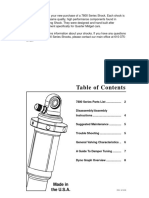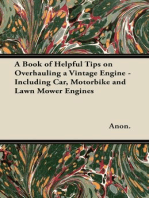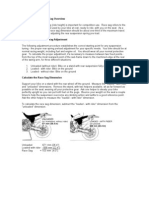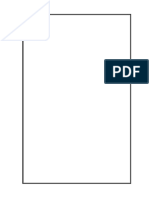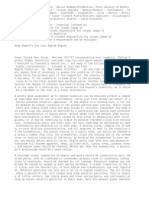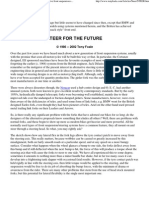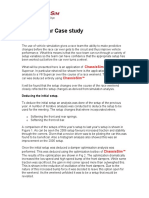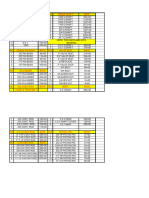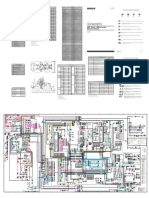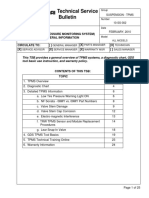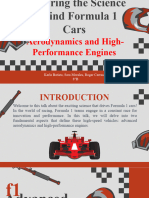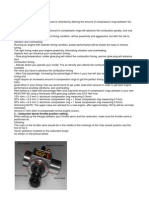0 ratings0% found this document useful (0 votes)
163 viewsTech110 PDF
Tech110 PDF
Uploaded by
Prasetyo AdiThis document discusses modifications that can be made to the XPAG cylinder head to increase power and efficiency. It begins by describing the design characteristics of a stock XPAG head, noting the valve sizes and port dimensions. It then outlines some modifications that can be made, such as increasing valve size, unshrouding the valves to improve airflow, and porting the intake and exhaust ports. The document stresses having any head work done by an experienced engine builder and cautions that simply increasing valve size alone may not improve airflow without additional modifications to the combustion chamber.
Copyright:
© All Rights Reserved
Available Formats
Download as PDF, TXT or read online from Scribd
Tech110 PDF
Tech110 PDF
Uploaded by
Prasetyo Adi0 ratings0% found this document useful (0 votes)
163 views4 pagesThis document discusses modifications that can be made to the XPAG cylinder head to increase power and efficiency. It begins by describing the design characteristics of a stock XPAG head, noting the valve sizes and port dimensions. It then outlines some modifications that can be made, such as increasing valve size, unshrouding the valves to improve airflow, and porting the intake and exhaust ports. The document stresses having any head work done by an experienced engine builder and cautions that simply increasing valve size alone may not improve airflow without additional modifications to the combustion chamber.
Original Title
tech110.pdf
Copyright
© © All Rights Reserved
Available Formats
PDF, TXT or read online from Scribd
Share this document
Did you find this document useful?
Is this content inappropriate?
This document discusses modifications that can be made to the XPAG cylinder head to increase power and efficiency. It begins by describing the design characteristics of a stock XPAG head, noting the valve sizes and port dimensions. It then outlines some modifications that can be made, such as increasing valve size, unshrouding the valves to improve airflow, and porting the intake and exhaust ports. The document stresses having any head work done by an experienced engine builder and cautions that simply increasing valve size alone may not improve airflow without additional modifications to the combustion chamber.
Copyright:
© All Rights Reserved
Available Formats
Download as PDF, TXT or read online from Scribd
Download as pdf or txt
0 ratings0% found this document useful (0 votes)
163 views4 pagesTech110 PDF
Tech110 PDF
Uploaded by
Prasetyo AdiThis document discusses modifications that can be made to the XPAG cylinder head to increase power and efficiency. It begins by describing the design characteristics of a stock XPAG head, noting the valve sizes and port dimensions. It then outlines some modifications that can be made, such as increasing valve size, unshrouding the valves to improve airflow, and porting the intake and exhaust ports. The document stresses having any head work done by an experienced engine builder and cautions that simply increasing valve size alone may not improve airflow without additional modifications to the combustion chamber.
Copyright:
© All Rights Reserved
Available Formats
Download as PDF, TXT or read online from Scribd
Download as pdf or txt
You are on page 1of 4
Where the Rubber Meets the
Road . Part I I I The Cylinder Head
By Dave Barnett
Vintage MG Club of Southern California
"The Torque Output of an
Engine is limited by just how
effectively we can make it
Breathe" David Vizard 1985
This month I will cover the XPAG
cylinder head. We will examine stock and
modified heads, to increase power, reliability
and yes even economy. For most of us,
rebuilding and modifying the cylinder head
should be left up to experienced engine
builders. You should make sure that the
company you are dealing with has the proper
equipment to perform the work. In this article
we will cover:
The inherent design chairestics of
a stock XPAG cylinder head
Modifications to increase
efficiency
After market cylinder heads
How to choose a shop that can
do the job right the first time
The inherent design characteristics of
a stock XPAG cylinder head
There is no question that the cylinder
head is where the power is made, it is in fact
the "Heart and Soul" of the engine. The design
of the XPAG head dates back to September of
1939 and was first used on the TB. There are
two basic design types. The "early" "Banana
Head" with short 1/2-inch spark plugs. Then
starting with XPAG/TD2/22735 a round water
hole head with used with longer-reach 3/4-inch
plugs. The thickness of a stock TC head is
76.65mm (3.018-inches) TD and TF XPAG
75.16mm (2.959-inch) TF XPEG 76.75mm
(3.021-inch) (Source: MG Racers News Letter Code 106 by
Mike Lewis, Bayou Racing)
Understanding that in its simplest form,
the XPAG engine is nothing more or less than
an air pump. A useful step toward appreciating
an engines ultimate power limitation is air flow.
When an engines ability to draw in more air
with increasing R.P.M. ceases, so does the rise
in power. In other words, the engine has hit
peak power. Of all the restrictions existing in
an induction or exhaust system, the cylinder
head proves the greatest impediment to flow,
and ultimately the limitation of an engines
power output. Within the cylinder head itself it
is the valve size and location that is most
important not necessarily the size of the ports.
The XPAG head utilizes siamesed intake
ports, where two cylinders share a common
carburetor. A stud boss separates the ports. The
intake volume is approximately 90cc's. The
intake valve head diameter is 1.299 inches. The
seat angle is 30 degrees. It is very common
today to find seats ground at 45 degrees
however as pointed out in last months article
seats cut at 30 degrees provide a 23% area
advantage at lifts up to 0.150. This is
approximately one half of the total lift of a
stock valve.
The exhaust port is square and measures
1.65 inches on each side. It is almost the same
size as an early small block chevy. The valve
head diameter is 1.221 inches. The seat angle is
30 degrees.
Modifications to increase efficiency
The first step toward understanding
cylinder head porting is appreciating the
importance of being able to isolate and deal
with flow restriction. Airflow starts at the air
cleaner and continues through the exhaust. A
high restriction air cleaner will restrict flow and
fuel economy will be degraded. Using an APT
Tapered K&N offset filter for 1 1/4-inch or 1
1/2-Inch S&U carburetors, is the first step
toward improving flow. You get the highest
filtering capability with out impeding airflow.
K&N filters designed specifically for the 1 1/4
and 1 1/2 S&U carburetors can be purchased
from Advanced Performance Technology by
calling; 800-278-3278.
The same is true for the muffler. There is
a lot of backpressure in a stock muffler.
Although it is a straight through design, the
little round holes inside the muffler impede
flow. According to David Vizard, a flow rating
of 2.2-2.5 cubic feet per minute per horsepower
will allow the engine to produce close to the
same power as it does on an open exhaust. We
can accomplish this or come very close by
using a high flow large volume muffler like the
new Flowmaster "50" Series with Delta-Flow
technology.
Once we have the Goesintos and
Gooutas fixed we can now focus on the
cylinder head.
Selecting the right parts
Finding a completely stock XPAG
cylinder head not an easy task. Most have been
shaved to some degree to make the surface flat
or to increase the compression ratio. Measure
your head to determine how much material has
been removed. Remember that when you
increase the bore size, you will also increase the
compression ratio. Increasing the compression
ratio will also improve economy.
Cylinder Head Porting
In order to get a better understanding of
the process and components, we need to know
where to start. First we will examine the valve
ratios and size and determine what effect they
have on our XPAG. Second we will examine the
combustion chamber and how we can improve
performance by unshrouding the valves. Third
we will break the port down into 3 sections and
discuses various modifications that improve
flow.
Valve Ratios and Size
According to David Vizard on an engine
that uses siamesed intake ports the intake
should flow approximately 43% to 54% more
than the exhaust. Although I do not have the
flow-bench data for a stock cylinder head we
can see that the difference in diameter between
the intake and exhaust valve is only 0.078-
inches. This is a very small difference.
The XPAG engine Data Service
Supertuning Manual by W.K.F. Wood edited
by Jerry Austin 11/99, suggest using larger
valves in the Stage IA configuration. On a stock
engine, with a bore diameter of 2.6181-inch,
the larger valves don't have much clearance.
The centerline distance between the valves is
approximately 1.6-inches the radius for the
large intake is .7087-inche the exhaust valve
radius is .6693-inch together the overall
diameter is 2.978-inch. The bore diameter is
2.6181-inch. The difference is approximately
.359-inch. Although the net valve lift is
approximately .315 for a stock cam, it is
important to check clearances especially valve
to piston clearance, which should be no less
than 0.100-inch.
The Combustion Chamber
And
Unshrouding the valves
First just installing a larger valve does
not guarantee increased flow. In a test
conducted by David Vizard, using a SuperFlow
SF 300 Flow Bench, on an 850 Mini
combustion chamber revealed the following. In
an unmodified 850 combustion chamber,
changing the stock 850 valve 1.093-inch, with a
larger 1.5625-inch 1100 valve, the 1100 valve
showed slight improvements between 0.075
and 0.200-inch lift, but at lifts higher than 0.200
the smaller valve flowed approximately 20
C.F.M. more air @ 25" pressure drop at 0.315-
inch lift. By unshrouding the valve 0.800-inch
radius as shown below, gave a substantial
increase in flow. Therefore a smaller diameter
valve that has been unshrouded may provide
better flow that just installing a larger valve.
Effect on airflow when a closed chamber head is
unshrouded to varying degrees.
"Sweeping the Chamber" is a method
used to unshroud the valve. Cutting the
chamber to the outside of the cylinder can
increase the flow. It is done using the Serdi
100. Following any modifications to the
combustion chamber, the volume of the
chamber must be measured and the new
compression ratio calculated.
Sweeping the Chamber
Intake & Exhaust Ports
I wouldn't ever discourage anyone from
porting his or her own cylinder head. I have in
the past, ported Small Block Chevy heads using
"Porting Templates" to determine the various
shape of the ports and valve pocket. However
with the advent of modern equipment like the
Serdi 100, a shop can save you a considerable
amount of time, and at the same time provide
consistency from port to port or chamber to
chamber.
Since we are focusing on a street engine
and not a racing engine, I don't think that we
need to port the head using a flow bench. But it
could be a nice project to port one cylinder,
make a mold using Blue-Sil a special latex and
silicone combination and make porting
templates from the mold.
To establish where our priorities lie in
reducing flow restrictions, we can divide the
XPAG port into three (3) sections.
Section one is for all particle purposes, a
straight run toward the bowl area. The intake
port feeds two cylinders, and is divided by a
stud boss. This boss does not isolate the two
intake runners since it is open in the back.
Section two is where the two ports
merge. The intake valve for the number one
cylinder is open; the intake valve of the
second cylinder is closed. Each cylinder "sees"
the entire port area. This siamesed port has its
shortcomings. Care should be taken not to
sharpen the "beak" behind the stud boss, as this
will restrict flow. Instead, it should have a nice
radius and blend into the bowl.
I wish I could tell you the optimum
shape of the stud boss but I can't. This is an
area where a flow bench could be used to
determine the optimum shape. My cylinder
head has about the same radius in the front as in
the back. The problem with this design is that
the air from the closed valve moves very slow
as it collides with the faster mixture from the
port with the open valve.
Section three is the bowl area under the
valve. It is also referred to as the valve pocket.
You may have herd term "pocket porting" this
in conjunction with the valve seat is the most
important part of the port.
After market Cylinder Heads
If you would like to run a high
compression engine and not overheat the
engine. Or, instead of making a large
investment in a stock head, then the "Ultimate
Cylinder head modification for your XPAG
engine is an aluminum head". Offered by
Brown and Gammonds LTD, in the U.K..
What you get is brand new "Laystall
Lucas" aluminum head. The head is supplied
with a 40cc combustion chamber as that
provides an 8.0:1 compression ratio. On a
1250cc engine, or a 9.0:1 compression ratio on
a 1466 engine. A close look at the head shows
that the ports are approximately 0.5-inches
longer than stock. The major down side is that
this head is really expensive.
How to choose a shop that can do
the job right the first time
As many of us know, rebuilding our 50+
year-old engines is getting expensive. For this
reason it is my opinion that we should seek out
the most qualified vendors who know what they
are doing with our cylinder heads, and have the
right equipment to do a proper job.
The Serdi Corporation manufactures one
of the best cylinder head valve seat and valve
guide machining systems. The Serdi 100 is a
self-centering valve-boring machine. The
cylinder head floats on a cushion of air until its
cutting head is perfectly aligned with the valve
guide, then it is locked into position for the
actual cutting process. This results in correct
alignment for the new valve seats with the
guide.
If you are looking for the best equipment this is it
Hales Automotive Machine Shop (714-
871-2054) located in Fullerton has a great
reputation for rebuilding the XPAG cylinder
head. A complete rebuild can be done for under
$250.00. According to John Seim " I've only
sent about 10 engine jobs (4 of my own) to him.
You might say that Alan Hail is an honorary
member of the VMG."
If you are looking for a shop that can
provide complete rebuild, porting services and
flow bench testing, then I recommend Advanced
Performance Technology. Although they
specialize in the MGA and beyond, they can do
an outstanding job on an XPAG head. This is
where I shop. They are located in Riverside
next to the K&N factory. Contact David Anton
at 800-278-3278.
Next month we will cover carburetors
intake and exhaust manifolds. Till then Happy
Motoring.
You might also like
- BMW R1250 GS K50 12 Service Manual - CópiaDocument1,288 pagesBMW R1250 GS K50 12 Service Manual - CópiaWilliams Andrade100% (2)
- Maxxforce 11 y 13Document2 pagesMaxxforce 11 y 13Ruju Ruju86% (29)
- 00 MSTNGDocument302 pages00 MSTNGdixon gonzalez100% (1)
- Eh Rig Shock ManualDocument75 pagesEh Rig Shock ManualapronelloNo ratings yet
- Sidecar General Instruction ManualDocument3 pagesSidecar General Instruction ManualTabon SkiNo ratings yet
- Penske 7800 Technical ManualDocument12 pagesPenske 7800 Technical ManualgeorgeNo ratings yet
- Motorcycle ErgonomicsDocument20 pagesMotorcycle ErgonomicsSanti UllaNo ratings yet
- Analysis of Change in Intake Manifold Length and Development of Variable Intake SystemDocument6 pagesAnalysis of Change in Intake Manifold Length and Development of Variable Intake SystemDarius TothNo ratings yet
- CFD of Clubman Roll CagesDocument18 pagesCFD of Clubman Roll CagesJoel ForbesNo ratings yet
- Moto3 - Honda Nsf250rDocument2 pagesMoto3 - Honda Nsf250rPrasetyo AdiNo ratings yet
- Motorcycle Chassis Design and Dynamics PDFDocument3 pagesMotorcycle Chassis Design and Dynamics PDFPrasetyo Adi40% (5)
- VOLVO G930B MOTOR GRADER Service Repair Manual PDFDocument16 pagesVOLVO G930B MOTOR GRADER Service Repair Manual PDFsekfsekmddde75% (8)
- 2013 Fork Rockshox Service ManualDocument83 pages2013 Fork Rockshox Service ManualXc Cristi0% (1)
- Gear Ratio Application Chart 150-151Document2 pagesGear Ratio Application Chart 150-151Gustavo MosqueraNo ratings yet
- Puma Race Engines - Cylinder Head Modifications - Part 1: Valve SeatsDocument4 pagesPuma Race Engines - Cylinder Head Modifications - Part 1: Valve SeatsRobert DennisNo ratings yet
- Southern Marine Engineering Desk Reference: Second Edition Volume IiFrom EverandSouthern Marine Engineering Desk Reference: Second Edition Volume IiNo ratings yet
- Ford Manual for Owners and Operators of Ford Cars and Trucks (1919)From EverandFord Manual for Owners and Operators of Ford Cars and Trucks (1919)No ratings yet
- A Book of Helpful Tips on Overhauling a Vintage Engine - Including Car, Motorbike and Lawn Mower EnginesFrom EverandA Book of Helpful Tips on Overhauling a Vintage Engine - Including Car, Motorbike and Lawn Mower EnginesRating: 5 out of 5 stars5/5 (1)
- Application of Magic Formula Tire Model To Motorcycle Maneuverability AnalysisDocument6 pagesApplication of Magic Formula Tire Model To Motorcycle Maneuverability AnalysisliezardNo ratings yet
- Proper Motorcycle Helmet Removal PDFDocument3 pagesProper Motorcycle Helmet Removal PDFzitrofjNo ratings yet
- Racing Motorcycle Dynamic Analysis ModelsDocument84 pagesRacing Motorcycle Dynamic Analysis Modelsaps uNo ratings yet
- Suspension - Spring Preload&Race SagDocument4 pagesSuspension - Spring Preload&Race Sagmakazica100% (2)
- Motorcycle Safety Factsheet Sep2010Document3 pagesMotorcycle Safety Factsheet Sep2010everlord123No ratings yet
- Determination of Anti Pitch Geometry L (/) - Acceleration (1/3)Document39 pagesDetermination of Anti Pitch Geometry L (/) - Acceleration (1/3)gashaw251No ratings yet
- Top Down ScVENGINGDocument20 pagesTop Down ScVENGINGshunmugeshNo ratings yet
- MotorcycleHelmet ImpactResponse IRCOBI 15 91Document11 pagesMotorcycleHelmet ImpactResponse IRCOBI 15 91deny ponimanNo ratings yet
- Dynojet Research Motorcycle Accessories 250Document31 pagesDynojet Research Motorcycle Accessories 250cesarNo ratings yet
- The Effects of Visual Training On VisionDocument6 pagesThe Effects of Visual Training On VisionEvelyn SepulvedaNo ratings yet
- 2013 s1000rr Riders Manual 3rd EditionDocument181 pages2013 s1000rr Riders Manual 3rd Editiongabao123No ratings yet
- Motorcycle Swing-Arm Design and ModificationDocument4 pagesMotorcycle Swing-Arm Design and ModificationbhupeshNo ratings yet
- Fsae Exhaust ReportDocument8 pagesFsae Exhaust ReportGodwin JerryNo ratings yet
- Motorcycle Connecting RodsDocument1 pageMotorcycle Connecting Rodscrower_scribdNo ratings yet
- Camber ThrustDocument3 pagesCamber ThrustKunal SuryavanshiNo ratings yet
- Design and Analysis of Camshafts (DOHC)Document23 pagesDesign and Analysis of Camshafts (DOHC)Esaam Jamil0% (3)
- Intake Manifold Design For A Formula Student VehicleDocument8 pagesIntake Manifold Design For A Formula Student VehiclenaveenNo ratings yet
- 2012 Motorcycle Data BookDocument39 pages2012 Motorcycle Data BookAVINASHNo ratings yet
- Hub Centres SteeringDocument29 pagesHub Centres SteeringSudheesh Kumar ENo ratings yet
- Fundamentals of Design and Manufacturing111111111Document10 pagesFundamentals of Design and Manufacturing111111111Pushpinder Singh Khalsa0% (1)
- Know About Motorcycle RidingDocument1 pageKnow About Motorcycle RidingDerek BoillatNo ratings yet
- CG Measurement of MotorcycleDocument9 pagesCG Measurement of MotorcyclePrasanna MahendiranNo ratings yet
- High Speed Valvetrain - Thomas RoodinkDocument34 pagesHigh Speed Valvetrain - Thomas Roodinkgabriel fagaNo ratings yet
- CSim Hand Calc Guide PDFDocument7 pagesCSim Hand Calc Guide PDFDionisis SpiliopoulosNo ratings yet
- Baja'18 Problem Statements 1Document2 pagesBaja'18 Problem Statements 1Shubham GuptaNo ratings yet
- ChassisDocument21 pagesChassisphamxuannam2002No ratings yet
- Motorcycle Safety Presentation 2Document29 pagesMotorcycle Safety Presentation 2vhlactaotaoNo ratings yet
- Vincent TechnicalDocument58 pagesVincent TechnicalCiprian MaiorNo ratings yet
- Diagrams of Racing MotorcycleDocument6 pagesDiagrams of Racing MotorcycleRenan Alves100% (1)
- Design and Optimization of Impact Attenuator For A Formula SAE Racing Car (Document12 pagesDesign and Optimization of Impact Attenuator For A Formula SAE Racing Car (Praveen BandaraNo ratings yet
- Where The Graphs Come FromDocument7 pagesWhere The Graphs Come FromRajaSekarsajjaNo ratings yet
- Front End Alignment - KartpediaDocument10 pagesFront End Alignment - KartpediaCODE0303456No ratings yet
- 1) Effect of Engine Speed On Intake Valve Flow Characteristics of A Diesel EngineDocument6 pages1) Effect of Engine Speed On Intake Valve Flow Characteristics of A Diesel EnginefitriasyrafNo ratings yet
- Porting and Cylinder ScavengingDocument2 pagesPorting and Cylinder Scavenging69x4No ratings yet
- F1-16 SetupManual PDFDocument24 pagesF1-16 SetupManual PDFVk3em100% (1)
- Brake Reaction Time MotorcycleDocument37 pagesBrake Reaction Time MotorcycleGeorge TsakatarasNo ratings yet
- Design and Fabrication of A Mounting Device For Connecting A Motorcycle and A SidecarDocument4 pagesDesign and Fabrication of A Mounting Device For Connecting A Motorcycle and A SidecarJeff PereyrasNo ratings yet
- Grand Prix Motorradmotoren Design Alternatives For MotoGP Engines Gordon P. BlairDocument14 pagesGrand Prix Motorradmotoren Design Alternatives For MotoGP Engines Gordon P. BlairLuizGustavoVicenteNo ratings yet
- Tony Foale Designs - Vyrus Suspension HistoryDocument7 pagesTony Foale Designs - Vyrus Suspension HistoryStuart CouttsNo ratings yet
- Shock Speed ArticleDocument10 pagesShock Speed ArticleKathryn Workman100% (1)
- Motorcycle Dynamics Library in ModelicaDocument10 pagesMotorcycle Dynamics Library in ModelicaSaufiy SarminNo ratings yet
- ChassisSim F3 Case StudyDocument6 pagesChassisSim F3 Case Studytushar girotraNo ratings yet
- Lecture - 3 Combustion Phases of SI and CI EnginesDocument21 pagesLecture - 3 Combustion Phases of SI and CI EnginesMuhammad SaqibNo ratings yet
- Servicing Instructions and Illustrated Parts List For Hewland FTR GearboxesDocument28 pagesServicing Instructions and Illustrated Parts List For Hewland FTR GearboxesIgnacio ManriquezNo ratings yet
- Öhlins Motorcycle Shock Owner ManualDocument12 pagesÖhlins Motorcycle Shock Owner ManualPete PetrášNo ratings yet
- Manufacturing Process of The PistonsDocument10 pagesManufacturing Process of The PistonsIvan Muñoz100% (1)
- Flowbench Design2 PDFDocument15 pagesFlowbench Design2 PDFsandy0% (1)
- Kosmic Knowledge PKT V2Document17 pagesKosmic Knowledge PKT V2DNo ratings yet
- V8 Supercar Case StudyDocument5 pagesV8 Supercar Case Studytushar girotraNo ratings yet
- Super Mastercam + Rra BRT 2017Document1 pageSuper Mastercam + Rra BRT 2017Prasetyo Adi85% (26)
- Affects of Alignment, Chain Tension and Tire PressureDocument2 pagesAffects of Alignment, Chain Tension and Tire PressurePrasetyo AdiNo ratings yet
- E Catalogue of MIKUNI INDONESIA PT PDFDocument1 pageE Catalogue of MIKUNI INDONESIA PT PDFPrasetyo AdiNo ratings yet
- Miniature InductiveDocument5 pagesMiniature InductivePrasetyo AdiNo ratings yet
- Suspension Setup PDFDocument11 pagesSuspension Setup PDFPrasetyo AdiNo ratings yet
- Baleno BrochureDocument14 pagesBaleno BrochureAbhinay SharmaNo ratings yet
- 2016 Kawasaki Versys 650 LT 65114Document178 pages2016 Kawasaki Versys 650 LT 65114rfsrsbNo ratings yet
- Reign X0: Frame Technology SpecificationsDocument1 pageReign X0: Frame Technology SpecificationsGde Pragma KrishnaNo ratings yet
- MTG Des OverhungDocument12 pagesMTG Des OverhungPaunescu CostinNo ratings yet
- Spare Parts Book: C-Service 3Document225 pagesSpare Parts Book: C-Service 3Dan DelfinoNo ratings yet
- HP0 DENSO Fuel Injection Pump Replacement 2004 With CTFDocument6 pagesHP0 DENSO Fuel Injection Pump Replacement 2004 With CTFDenisEcheverri100% (2)
- Motor Doosan L136tiDocument2 pagesMotor Doosan L136tiJulio SanchezNo ratings yet
- Zx200-5g Engine ManualDocument234 pagesZx200-5g Engine ManualPrudz95% (44)
- Mahaveer Price ListDocument6 pagesMahaveer Price Listpurchase sigmaairsourceNo ratings yet
- 980F Series II Wheel Loader Electrical System: Electrical Schematic Symbols and DefinitionsDocument2 pages980F Series II Wheel Loader Electrical System: Electrical Schematic Symbols and DefinitionsRafa GarciaNo ratings yet
- TPMS (Tire Pressure Monitoring System) TSBDocument25 pagesTPMS (Tire Pressure Monitoring System) TSBlooseshengjiNo ratings yet
- Libro de LlavesDocument142 pagesLibro de Llavesadris banquethNo ratings yet
- Translogic Is4 Installation ManualDocument13 pagesTranslogic Is4 Installation ManualIrfan SukendarNo ratings yet
- ClutchesDocument23 pagesClutchesabddul128No ratings yet
- f1 Science SpeechDocument13 pagesf1 Science Speechteacherroger2020No ratings yet
- Chery-QQ S11 Transmisión Parte 3Document12 pagesChery-QQ S11 Transmisión Parte 3limadacarlosNo ratings yet
- Spesifications of Hino Ranger FL 235 260 Series 6X2Document4 pagesSpesifications of Hino Ranger FL 235 260 Series 6X2DidinRohidinNo ratings yet
- BSP Hammer JCBDocument14 pagesBSP Hammer JCBashish sahaNo ratings yet
- Engine Valve Failure Modes (1100, 1105)Document1 pageEngine Valve Failure Modes (1100, 1105)A z DNo ratings yet
- En125 Part List OldDocument0 pagesEn125 Part List OldBhakti PermanaNo ratings yet
- Novarossi Rex 57 Carburetor Setting and TIPSDocument3 pagesNovarossi Rex 57 Carburetor Setting and TIPSchainman_No ratings yet
- Tencreng0003 Ecu ControlDocument24 pagesTencreng0003 Ecu ControlAly AbdelhamedNo ratings yet
- ZF 2000Document7 pagesZF 2000talabiz0% (1)
- The Muncaster Steam-Engine Models: 2-Double-ActingDocument3 pagesThe Muncaster Steam-Engine Models: 2-Double-ActingАлексей МоисеевNo ratings yet





